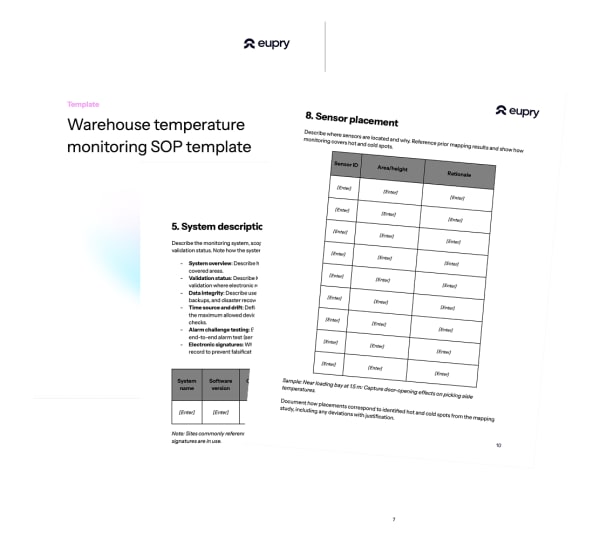Pharmaceutical warehouse monitoring: How to stay GDP compliant
Pharmaceutical warehouses need continuous monitoring to prove protect the quality of sensitive pharma products. Learn how to design GDP-compliant warehouse temperature monitoring: From sensor placement to alarm strategy + get a free SOP template aligned with GDP and USP <1079.4> requirements.
Get a ready-to-use SOP template for monitoring - from placement to alarms, responsibilities, and documentation.

What are the GDP requirements for warehouse monitoring
Most regulators expect monitoring to be based on mapping results and to be permanent, risk-based, and documented – and for good reason. EU GDP 3.2.1 and USP <1079.4> explicitly require storage areas to be qualified before use and continuously monitored. WHO technical supplements and ISPE good practice guides provide detailed expectations.
- Mapping first: Monitoring must follow a completed mapping study.
- Placement by risk: Sensors must be placed in hot and cold spots and representative zones.
- Records: Monitoring data must be complete, traceable, and linked to calibration.
- Audit trail: Electronic systems must provide retrievable, time-synchronized records with controlled access.
Also read: Pharmaceutical warehouse compliance: GDP requirements and best practices
How to place warehouse monitoring sensors after mapping
Sensor placement must follow the results of the mapping study. This ensures that permanent monitoring reflects the true performance of the warehouse environment and that conditions are consistently representative of risk areas. Regulators such as WHO and ISPE stress that incorrect placement is one of the most common reasons for audit findings, because data collected does not reflect real storage risks.
- Hot and cold spots: Sensors should be fixed at the warmest and coldest mapped points, typically corners, near HVAC inlets, and areas with poor circulation.
- Representative areas: Typical storage zones, mezzanines, and doorways must also be covered to show how products are actually stored and handled during operations.
- Transitional zones: Door openings, staging areas, and loading bays often experience fluctuations. Adding sensors here documents operational risks.
- Risk-based additions: Highly sensitive products, seasonal variability, or historical excursions may justify placing extra sensors beyond minimum requirements.
Also read: Temperature mapping for GDP pharmaceutical warehouses: Step-by-step guide

Download your free warehouse monitoring SOP template
Get a ready-to-use SOP template for pharmaceutical warehouse monitoring — covering sensor placement, alarm limits, responsibilities, and documentation in one step-by-step guide.
How to design a GDP-compliant warehouse alarm strategy
An effective alarm strategy protects products without overwhelming staff with false alerts. Regulators expect predefined thresholds, responsibilities, and escalation paths.
- Thresholds: Set based on label ranges, mapping variability, and risk profile.
- Responsibilities: Define who investigates alarms and under what timeframes.
- Escalation: Specify when and how issues are escalated if unresolved.
- Documentation: Record every alarm, action, and resolution for audit readiness.
- Reducing noise: Avoid alarm fatigue by fine-tuning limits and separating minor events from true deviations.
Also read: How to make your temperature monitoring audit-ready
How often should warehouse monitoring data be reviewed
Monitoring is not a one-time setup. GDP requires routine reviews to refine the program, tighten thresholds, and address risks. USP <1079.2> also highlights the role of mean kinetic temperature (MKT) in assessing storage excursions, which can be part of trend reviews. Reviews should be conducted monthly or quarterly depending on product risk, with results used to optimize sensor placement and adjust alarm limits. Documenting these reviews – along with corrective actions and rationales – ensures audit readiness and provides evidence of continuous improvement.
Also read: Continuous temperature mapping – eliminate re-mappings with Eupry
How to maintain audit readiness in warehouse monitoring
Audit readiness goes beyond storing monitoring data – it is about being able to demonstrate, on demand, that your warehouse operates in full compliance. Inspectors will often ask to see calibration certificates, alarm histories, and evidence that reviews are performed regularly. Systems that automate record keeping and link calibration directly to each device make this process faster and more reliable. It is not enough to have the data – it must be organized, traceable, and presented in a way that convinces regulators of ongoing control. For global operations, the ability to retrieve records centrally also strengthens oversight.
- Calibration traceability: Certificates must be linked to each sensor ID and location so auditors can verify accuracy instantly.
- Electronic records: Systems must provide backups, time synchronization, access controls, and a complete audit trail.
- Reporting: Complete audit-ready reports should be exportable in just a few clicks to reduce inspection stress and save time.
Also read: Smarter temperature monitoring for GMP and GDP compliance
How to manage warehouse monitoring across multiple sites
For organizations operating several warehouses, monitoring becomes a question of consistency and control. Without harmonized SOPs and central oversight, quality gaps and duplicated work can occur. Regulators increasingly expect evidence that monitoring is standardized across all locations and that deviations are handled consistently. A central platform reduces the risk of local variations and gives HQ visibility in real time.
- SOPs and templates: Use standardized alarm strategies, responsibilities, and reporting across sites so processes are consistent.
- Central dashboards: Enable HQ to track alarms, calibrations, and deviations in real time, ensuring transparency for leadership and inspectors.
- Change control: Apply consistent processes so that any layout or HVAC modifications at one site automatically trigger the right validation and monitoring updates.
What are GDP and CEIV monitoring requirements for logistics warehouses
GDP focuses on maintaining labelled storage conditions across facilities, while CEIV adds aviation-specific expectations such as chain-of-custody, training, and handover documentation. For logistics operators, aligning with both frameworks is critical to win pharmaceutical clients who demand proof of GDP compliance and often require CEIV as a benchmark for air cargo quality. Monitoring systems must therefore be robust enough to cover both day-to-day storage conditions and rapid, auditable handovers in transit hubs.
- Alarm ownership: Define who responds to alarms during short storage windows.
- Handover records: Ensure data is retrievable and linked to transport lane qualification.
- Rapid audits: Monitoring evidence must be quickly available for certification and audits.
Also read: How to efficiently achieve your CEIV pharma certification
Common pitfalls in pharmaceutical warehouse monitoring
Even advanced teams often miss the same points. Anticipating them prevents rework and audit failures. Inspectors frequently report the following issues:
- Poor placement: Sensors are installed in convenient locations instead of hot and cold spots identified in mapping, leading to data that does not represent real risks. This often results in audit findings because monitoring records cannot demonstrate control in critical areas.
- Alarm fatigue: Alarms are triggered too frequently because thresholds are not risk-based, causing staff to ignore warnings and potentially miss critical deviations. Regulators view alarm fatigue as a sign of poor quality oversight.
- Incomplete records: Missing calibration certificates, absent deviation reports, or incomplete CAPA documentation undermine data integrity and lead to audit findings. Inspectors expect every alarm, deviation, and corrective action to be fully documented.
- Fragmented systems: Using multiple vendors or non-integrated solutions creates inconsistencies, slows audits, and makes centralized oversight nearly impossible. Multi-site organizations especially risk discrepancies between facilities if monitoring is not harmonized.
Each of these pitfalls is preventable with risk-based planning, harmonized SOPs, and digital tools that maintain traceable, audit-ready data across sites. Training staff to understand these common issues and building processes that address them proactively can dramatically reduce audit risk.
Also read: Temperature mapping: tips, frameworks, and pitfalls
Get a free warehouse monitoring SOP template
Download a ready-to-use SOP template for pharmaceutical warehouse monitoring: From sensor placement, alarm limits, responsibilities, and documentation in one step-by-step guide.

FAQ about pharmaceutical warehouse monitoring
Automated temperature monitoring built for GDP
For the world’s most regulated industries, Eupry delivers automated, Wi-Fi-based, and wireless monitoring in real-time. Eliminate manual work, track compliance on any screen, and get a full digital overview across facilities, units, and departments.
- Audit reports in 3 clicks: Generate digital reports across TCUs, facilities, and departments.
- Live monitoring on any screen: Get instant SMS/email alerts and wireless data loggers that automatically send data to your platform.
- Automated calibration included: Calibration without manual tracking or extra cost is part of the solution.
